2020人教版高一英语必修二全册教学课件
- 格式:pptx
- 大小:35.07 MB
- 文档页数:238
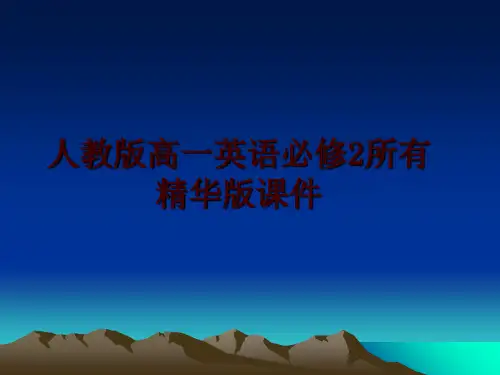
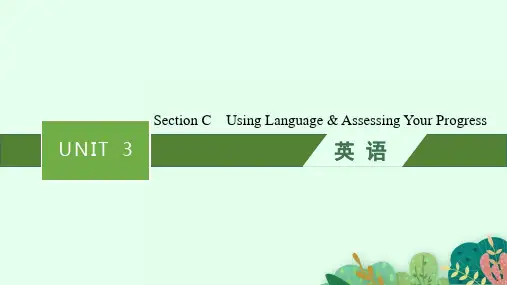
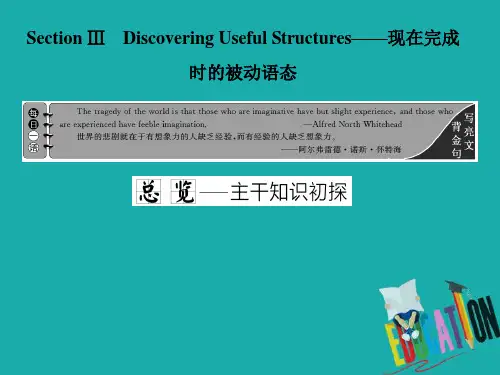
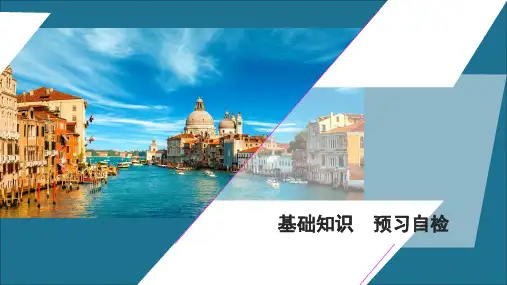
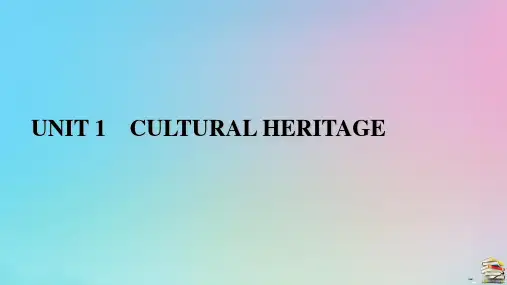
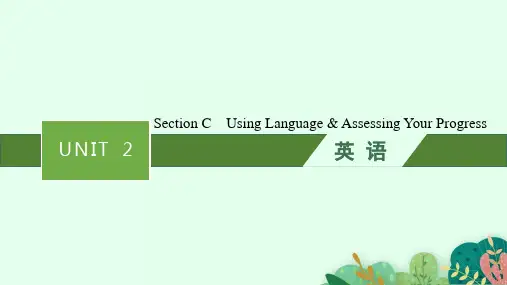
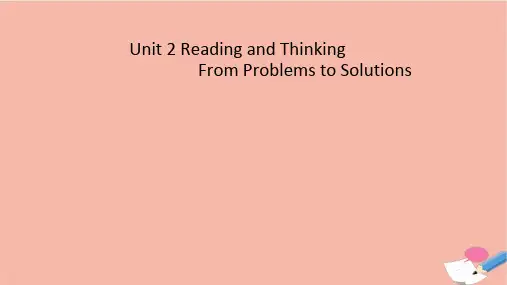
Unit 2 Reading and ThinkingFrom Problems to SolutionsLearningObjectivesBytheendofthisclass,youwillbeabletoknow the process of how Egypt solved the problems of building the Aswan Dam.predict the content of a passage from its title and photos in the passage.express views about the cultural heritage protection and think critically.know the importance of international cooperation in solving difficult problems.Relocation of Abu Simbel TempleWhat do you see in the video?The Egyptian government wantedto build a new dam in the Nile butthey met a big problem. Finally,they managed to solve theproblem and build up the newdam.Prediction FROM PROBLEMS TO SOLUTIONS01 Textual AnalysisThefunction:Tointroducethetopic Economic development is necessary if we want to improve society.There comes a time when the old must give way to the new,and it is not possible to preserve everything from ourpast as we move towards the future.Finding and keeping the right balance between progress and the protection of cultural sites can be a big challenge.general statementFinding and keeping the right balance between progress and the protection of cultural sites can be a big challenge. Big challenges, however, can sometimes lead to great solutions.General statementBig challenges,however,can sometimes lead togreat solutions.In the 1950s,the Egyptian government wanted to build a new dam across the Nile in order to control floods,produce electricity,and supply water to more farmers in the area.But the proposal led to protests.Water from the dam would likely damage a number of temples and destroy cultural relics ꢀthat were an important part of Egypt's cultural heritage.After listening to the scientists who had studied the problem,and citizens who lived near the dam,the govern situation Problem To introduce the problem: the contradiction between building a new dam and protecting the cultural heritage in Egypt.A committee was established to limit damage tothe Egyptian buildings and prevent the loss ofcultural relics.The group asked for contributionsfrom different departments and raised funds withinsolutions the international community.Experts investigatedthe issue,conducted several tests,and then made aproposal for how the buildings could be saved.Finally,a document was signed,and the work beganin 1960.Solutions to the problem.The project brought together governments and environmentalists from around the world.Temples and other cultural sites were taken down pieceꢀbypiece,and then moved and put back together again in a place where they were safe from the water.In 1961,German engineers moved the first temple. Over the next20years,thousands of engineers and workers rescued22temples and countless cultural relics.Fifty countries donated nearly$80million to the project.solutions resultsSolutions: how the temples were moved.too challenging!When the project ended in1980,it wasconsidered a great success.Not only had thecountries found a path to the future that did not evaluation run over the relics of the past,but they had alsolearnt that it was possible for countries to worktogether to build a better tomorrow.evaluation: the problem was solved and it was a success.The spirit of the Aswan Dam project is still alivetoday.Perhaps the best example is shown byUNESCO,which runs a programme that preventsworld cultural heritage sites around the world fromconclusion disappearing.If a problem seems too difficult for asingle nation,the global community can sometimesprovide a solution.Conclusion: we can find a solution between progress and the protection of cultural sites.Para.6Para.5Conclusion ꢀeꢀvaluation ꢀsolutionsolutionPara.4Para.3An ꢀexampleꢀparticularPara.2Para.1ꢀproblemGeneral ꢀ02 Situational Analysis1.What is the main idea of the text?The main idea is to tell readers the process of rescuing the temples to show the challenge between the progress and the protection of cultural relics. 2. What is the relationship involved in the text?Egyptian government, UN, together with governments and environmentalists from around the world.Writing orderFinish ꢀthe ꢀtimeline ꢀwith ꢀthe ꢀinformation ꢀfrom ꢀthe ꢀtext ꢀand ꢀtell ꢀme ꢀhow the ꢀtext ꢀis ꢀdeveloped .Thread:ꢀdifferent ꢀtime ꢀstagesOver ꢀthe ꢀnext ꢀ20ꢀyears1959196019611980ꢀꢀꢀꢀꢀꢀꢀThe ꢀThe ꢀThe ꢀfirst ꢀtemple ꢀis ꢀThe ꢀproject ꢀstarts .The ꢀproject ꢀis ꢀcompleted.temples ꢀand ꢀcultural ꢀrelics ꢀare ꢀbeing ꢀgovernm ent ꢀasks ꢀthe ꢀUN ꢀmoved.for ꢀhelp.rescued.Transition:ꢀthe ꢀprogress ꢀof ꢀrescuing ꢀthe ꢀtemplesꢀtell readers the process of rescuing the temples.Field:______________________________________________.Tenor: _____________________________________________.Egyptian government, UN, together with governmentsand environmentalists from around the world.Mode: _____________________________________________.ꢀin chronological/time order and problem-solution patternTips:语场(field):指发生的事或正在被谈论的事,进行的社会活动(what's going on)语旨(tenor):指参加者的身份和他们之间的关系(the role of relationship in the situation in question)语式(mode):指语言在具体环境中所起的作用,是书面口头的形式,是说明,评论还是劝说等(the means of communication)Topic-related expressions TThere comes a time whengive way toit is not possible to ……can be a big challenge big challengesdamage a number of templesdestroy cultural relics Topic⑤—result①It was considered a big success.②find a path to future③it was possible for countries to work together to build a better tomorrow.Topic④—solutions …were taken down piece by piece, and then moved and put back together again Topic⑥—significanceThe spirit of…is still alive today. The best example is shown by…If a problem seems too difficult for …, …can sometimes provide a solutionwere safe from donate …to the project03 Pragmatic AnalysisꢀPragmatic Analysis1.There are so many cultural relics to be rescued. When we rescue them andhave problems, what can we learn from the passage?If the problem is too difficult for a single nation, we can turn to global community for help. Cultural relics need the protection of the whole world.2.Who do you think are its target readers?Its target readers may be those who are interested in protecting cultural relics.04 Thinking Practice and Application1. A lot of money was spent to protect the temples. Do you think it was worthwhile? Why?I think it was worthwhile to spend money on protecting the temples because their value is priceless in terms of cultural heritage2. Why do you think so many countries contributed funds and offered help to the Egyptian project?I think that many countries helped because Egyptian history and relics are world-famous and are highly valued around the world as part of our shared cultural history.Creative thinking:“If a problem seems too difficult for a single nation, the global community can sometimes provide a solution.” What can you learn from the sentence?From the sentence we can learn that in our daily life we should not hide ourselves from others but find help from our friends or families when we meet a difficult situation.Language ApplicationThe Forbidden City is being badly damaged nowadays. Can you analyze the reasons and find out the solutions to rescue it? You can refer to the following pictures and the above topic-related lexis in this class.HomeworkWrite a passage to introduce the problems of the Forbidden City and the solutions within 80 words.。
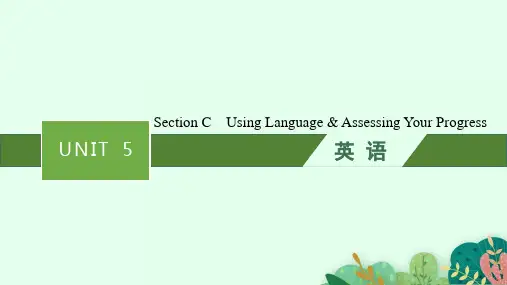
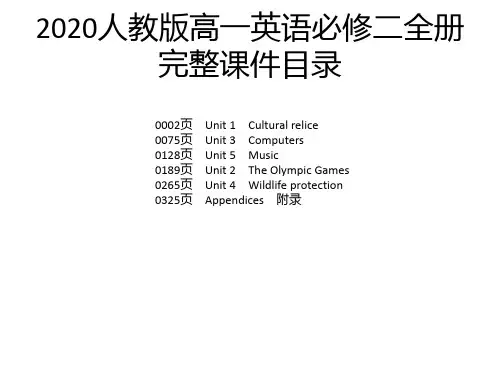
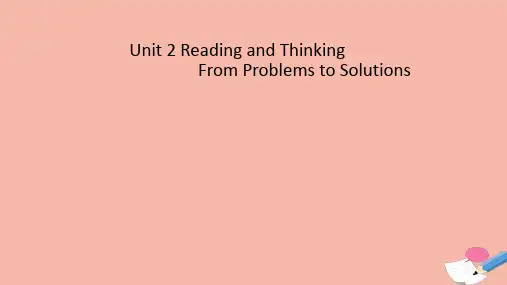
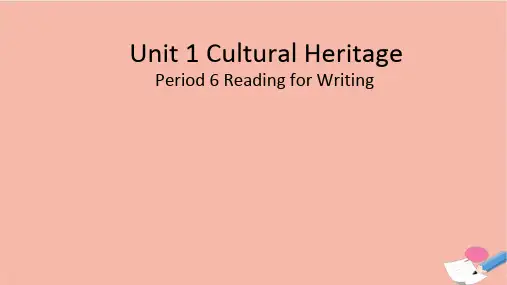
Unit 1 Cultural Heritage Period 6 Reading for WritingLearning AimsBy the end of this period, you will be able to1. understand a news report of digital technology making images of cultural relics of Mogao Caves in Dunhuang;2. master the structure and language characteristics of news writing;3. write a news report on the protection of cultural relics of common man.4. improve Ss’ awareness of preserving cultural heritage.Mogao Caves Dunhuang Mogao Grottoes Digital Exhibition CenterTask 1 First readingRead the news report first, and then answer the following questions: 1. What are the researchers and scientists trying to do? What modern technology are they using?2. Why are so many people interested in the Mogao Caves?3. What do you think of the researcher’s opinion in the last paragraph?Task 2 Second readingRead the text again and finish the table.A ꢀNews ꢀReportStructureꢀContents Characteristics ꢀAttractive and outstandingHeadline Those that can get reader’s attention ꢀTell readers who, what, where and why.Inclusive and general Lead sentenceꢀConcrete ,objective true BodyExplain what the person or group does.and persuasive ꢀEnding A short summary.Inclusive and generalTask 3 Organization and LanguageRead the text again and marked the 7 parts in the passage.A.lead sentence导语B. Direct quote直接引用语ꢀꢀꢀꢀC. Paraphrase解释D. Background information背景信息E. Reporting verbs引述动词F. Words to show comparison/contrast表示比较Headline:write a title to get the readers' attentionlead sentence:to tell the readers who, what, whereand why.paraphrase:简要解释专业词汇background informationBody : To tell thereaders the facts, details,examples, etc.reporting verbTask4 SummaryHeadlineLead sentenceA News ReportBodyEndingWritingHere are some interview notes about two persons who work to protect our cultural heritage. You can choose one of them and write a news report for him.Chen Lei, Wuhan Protectors of the Past, Wuhu•Protect old houses•senior teacher•takes photos of old buildings •wants to preserve cultural heritage •interviews old people •Help repair buildings•Look for cultural relics •Show cultural relics to the public •Raise money•writes about the buildings•visits schools to tell students about•Repair temples and cultural relicsTask 1 Have a brainstorm and finish the outline:Chen Lei Your choice is ________________________.Think about an attractive headline for him:A Picture is worth A Thousand Words _______________________________________________Write a lead sentence:Chen Lei is a senior teacher who takes photos of old buildings ___________________________________________________________in Wuhan in order to preserve the city's cultural heritage.Think about the theme of your news report:To praise Chen Lei and tell people the significance of what he has done.________________________________________________To make your news more persuasive, you can add _d _ir _e _c _t _q _u _o _t _e ____to your writing.To make your sentences more advanced, you can use__________r _e _la _t _iv _e ______clauses that we’ve learned in this unit.Task 2Complete your drafts. Then exchange drafts and use the checklist to give feedbacks on each other's draft.□Is there a title?□Does the lead sentence tell the reader about the situation?□Has the writer included details and explanations?□Are there quotes and paraphrases?□Does the writer use relative clauses to identify people, places, things, times, etc.?□Does the writer end with a short summary?□Are there any grammar or spelling mistakes?HeadlineA Picture Is Worth a Thousand WordsLead SentenceChen Lei is a senior teacher who takes photos of old buildings in Wuhan in order to preserve the city's cultural heritage.BodyEvery day, Chen Lei takes his camera and walks patiently through the older parts of the city. Over the years he has taken thousands of pictures of old buildings to create a record for his fellow citizens in the present and future. Another important part of his project is the interviews he conducts with elderly residents. Often these stories help to bring the interesting histories of the buildings to life, giving them their place in the human stories of Wuhan's citizens He writes about the buildings, their inhabitants and the stories that weave them together. He also visits schools to tell students about their cultural heritage. EndingNeither people nor buildings last forever, but Chen Lei' s photos can help us remember them. The stories that accompany them also help build a picture of life for future generations to hear and add their own stories, too.HomeworkWrite a news report about the Nanhai No.1 on textbook page 65.。